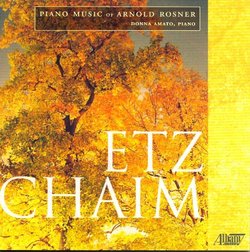Rosner's Keyboard World
Thomas F. Bertonneau | Oswego, NY United States | 11/11/2009
(5 out of 5 stars)
"On the Amazon website I have reviewed a number of CDs devoted to the work of Arnold Rosner, a New Yorker whose music in all genres is couched in an immediately appealing tonal idiom drawing also on the modes of Medieval plainchant and Jewish cantilation. Rosner has composed a large body of work in the five decades of his active mature artistic life. He has had the fortune in recent decades of an appreciable number of recorded performances to disseminate his music including, recently, a CD program of his three numbered piano sonatas and other, shorter works for piano. Rosner's music has virtues galore, not least clarity of structure that aids powerfully in admitting lay-listeners to his artistic world. Consider the piece "Adam and Eve," an expression of Rosner's adolescence that attests his early development and that forecasts the confidence of his mature oeuvre. The main motif of the work is derived from the rhythmic pulse of the phrase "Adam and Eve" and the composer works out the material melodically while never losing sight of the basic pulse. The three piano sonatas neatly punctuate the chronology of Rosner's creativity. Rosner is basically a sonata-form composer, not averse however to rhapsodic development of thematic material on the model of the Renaissance madrigal or the Baroque keyboard fantasy. The material is memorable and gratifying. Nowhere, contrary to the claim in a Fanfare Magazine review, does Rosner "sound like" Hovhaness, or inflict insipidity on the listener, or otherwise violate musical propriety or insult musical integrity. That review is one of the most egregious that I have seen. Let us suppose the absolute right of the reviewer to dislike Rosner's music. He would have been truer to morality simply to disdain to address the disc and its program. The editor of journal, if he knew in advance that the reviewer would be so averse to the assignment, might have done the civilized thing and sent the CD to another member of his writing staff.
To return to the music: Sonata No. 1, in three movements, has an identifiable American sound; it eschews excessive chromaticism in its harmonies and relies on open chord-structures and traditional harmonic progressions. On the other hand, it demonstrates the composer's contrapuntal skills, interweaving melodic voices ingeniously. Orchestrated, Sonata No. 1 would make a convincing Symphonia Brevis. Sonatas Nos. 2 and 3 are more complex, more motivic in their construction than thematic, and showing an awareness of the kinds of musical processes that one encounters in the music, say, of Bartok or Hindemith. In Sonata No. 2, Rosner avails himself of Baroque forms: two toccatas frame a central passacaglia. The passacaglia is especially moving. Rosner often incorporates "Jewish" motifs, as did Ernest Bloch; and occasional melismas are reminiscent of the Synagogue, but it is an "ethnic flavor" sparingly introduced. Perhaps such touches led the Fanfare reviewer to think of Hovhaness, whose copious output does entail repetition and a good deal of formulaic writing in mock-Eastern styles. That has nothing to do with Rosner.
One can understand readily why the pianist Donna Amato invests in this music. One can understand why Albany, a CD producer of impeccable taste, has issued the album.
"


 Track Listings (7) - Disc #1
Track Listings (7) - Disc #1